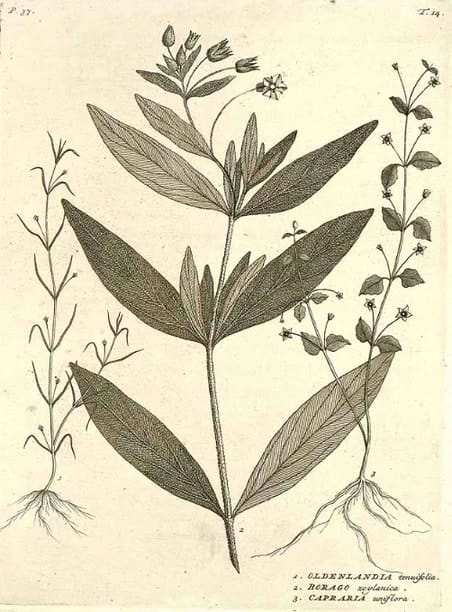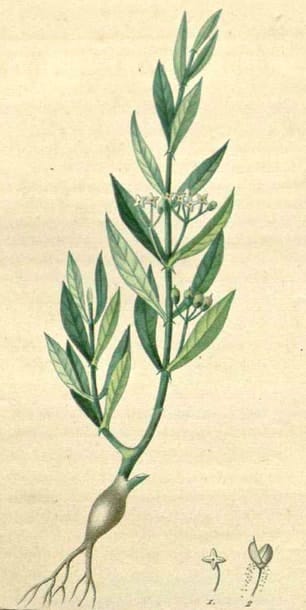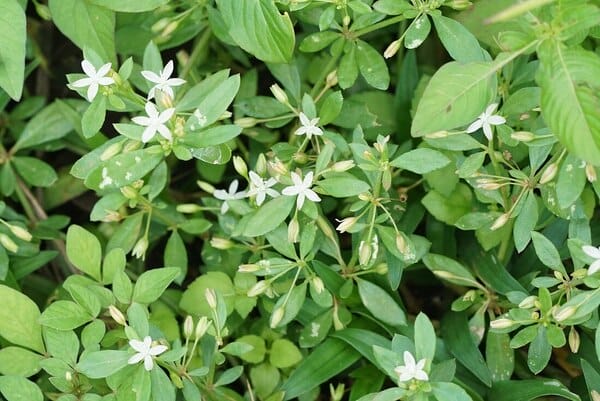Hedyotis, Bai Hua She She Cao 白花蛇舌草
Bai Hua She She Cao (TCM)
Kshetraparpata (Ayurveda)
Flora Indica (1768)
Flore médicale des Antilles , 1821)
Hedyotis corymbosa (Photo by
Vengolis ) (
Wikimedia )
Botanical name: Hedyotis (syn. Oldenlandia) spp. H. diffusa (syn. Oldenlandia diffusa) (TCM) H. corymbosa (syn. Oldenlandia corymbosa) (TCM, India) H. pinifolia (TCM) H. tenuifolia (syn. Oldenlandia tenuifolia) (TCM) H. herbacea (India) Parts used: Herb
Temperature & Taste: Cold, dry. Bitter, Sweet
Classification: B. Clears Heat and Toxin
Uses: 1. Clears Heat and Poison, Reduces Abscesses:
-Toxic Sores, Ulcers and Abscesses
-Internal Abscesses, Acute Appendicitis
-Sore Throat, Laryngitis, Tonsillitis from Heat-Toxin
-Lung-Heat Cough, Dyspnea, Pneumonia
-also Dysentery, Hepatitis
-used similarly, regarded as a Blood purifier in Ayurveda
-Snake Bite (proven effect against Snake Venom)
2. Clears Heat and Toxin, Resolves Masses:
-Toxic Swellings, Scrofula, Tumors
-Prostatitis
-recently important in Cancer treatment
-water extract is effective against various cancer cell lines; Iridoids, Anthraquinones, Flavonoids, Triterpenoids and Polysaccharides contribute to the effect.
3. Clears Damp-Heat, Resolves Damp, Promotes Urine:
-hot, painful Urine, Urinary Tract Infection
-Dribbling or Obstructed Urine, Strangury
-Diarrhea (Ayurveda)
-Jaundice
4. Externally:
-Sores, Carbuncles
–
topically to Leukoplakia -Leprosy
Dose: Decoction: 10–30 grams
Comment: This has become one of the important anti-cancer medicines in modern China.
Substitute: In Kerala, India, Oldenlandia is used as a substitute for Fumitory. Fumitory is also used and can be substituted for most indications.
Main Combinations: Often combined with
Scutellaria barbata Ban Zhi Lian for Tumors and Cancers.
1. Boils, Abscesses, Toxic Swellings:
i. Hedyotis
Bai Hua She She Cao with Dandelion (
Pu Gong Ying ), Violet (
Zi Hua Di Ding )
ii. Hedyotis
Bai Hua She She Cao with Lonicera
Jin Yin Hua , Forsythia
Lian Qiao 2. Sore Throat, Tonsillitis:
i. Hedyotis
Bai Hua She She Cao with Figwort (
Xuan Shen ), Platycodon
Jie Geng ii. Hedyotis
Bai Hua She She Cao with Burdock seed (
Niu Bang Zi ), Licorice
iii. Hedyotis
Bai Hua She She Cao with Isatis leaf (
Da Qing Ye ), Chrysanthemum indicum
Ye Ju Hua, Violet (
Zi Hua Di Ding )
iv. Tonsillitis,
Hedyotis
Bai Hua She She Cao , Scutellaria Huang Qin , Forsythia Lian Qiao , Figwort (Xuan Shen ), Isatis Ban Lan Gen , Platycodon Jie Geng , Licorice, 3. Strangury, obstructed Urine, Hedyotis
Bai Hua She She Cao with Water Plantain (
Ze Xie ), Plantain seed (
Che Qian Zi ), Agrimony (
Xian He Cao ), Coptis
Huang Lian (as in
Long Qing Pian )
4. Diarrhea with Fever, Hedyotis
Bai Hua She She Cao with Swertia, Cyperus rotundus, Tinospora, Ginger (Ayurveda)
5. Appendicitis:
i. Hedyotis
Bai Hua She She Cao with Rhubarb (Da Huang), Paeonia
Mu Dan Pi ii. Hedyotis
Bai Hua She She Cao with
Da Huang Mu Dan Tang (a formula).
6.
Cholelithiasis, Hedyotis
Bai Hua She She Cao with Artemisia
Yin Chen Hao , Madder (
Qian Cao )
7. Hepatitis:
i. acute Icteric Jaundice from Hepatitis, Hedyotis
Bai Hua She She Cao , Self Heal (
Xia Ku Cao ) (30 grams each), Licorice (15 grams). This was used for 72 patients with 100% effectiveness. Average length of treatment was 25 days.
ii. Chronic Hepatitis, Hedyotis
Bai Hua She She Cao with Astragalus
Huang Qi , Atractylodes
Bai Zhu , Artemisia
Yin Chen Hao , Dandelion (
Pu Gong Ying ), Salvia
Dan Shen (as in
Yi Gan Ning Keli )
iii. Hepatitis B, Hedyotis
Bai Hua She She Cao , Lysmachia Jin Qian Cao (20 grams each), Curcuma Yu Jin , Isatis Ban Lan Gen , Cyperus Xiang Fu , Salvia Dan Shen , Paeonia Bai Shao (15 grams each), Artemisia Yin Chen Hao , Bupleurum Chai Hu, Gardenia Zhi Zi (12 grams each), Licorice (5 grams). Decoct and take as a dose once daily. 8. Gastric Hyperplasia and Intestinal Metaplasia, Hedyotis
Bai Hua She She Cao with Smilax
Tu Fu Ling , Bletilla
Bai Ji , Dandelion (
Pu Gong Ying ), Paeonia
Bai Shao , Cyperus rotundus (
Xiang Fu ), Licorice (as in
Xiao Wei Yan San ). In clinical trials it was found to have an effective rate of 92%.
9. Pneumonia in children, an injection is prepared from Hedyotis
Bai Hua She She Cao in China which has been found effective.
10. Epididymal stagnation after vasectomy, Hedyotis Bai Hua She She Cao (20 grams), Phellodendrum Huang Bai , Figwort (Xuan Shen ), Rehmannia Sheng Di, Forsythia Lian Qiao, Lychee pip (Li Zhi He ), Paeonia Bai Shao (15 grams each), Safflower (Hong Hua ) 10 grams, Sparganium San Leng (12 grams), Achyranthes Niu Xi (12 grams), Licorice (5 grams). Decoct to be taken daily. Prostatitis, take
Hedyotis Bai Hua She She Cao as common tea throughout the day.
12. Cancer:
i. often Hedyotis
Bai Hua She She Cao is combined with Scutellaria barbata
Ban Zhi Lian ii. Breast and Lymphatic Cancers, Hedyotis
Bai Hua She She Cao is used with Asparagus
Tian Men Dong .
iii. Gastric or Esophageal Cancer from Phlegm and Heat with Qi and Blood stagnation, Hedyotis
Bai Hua She She Cao with Dandelion (
Pu Gong Ying ), Scutellaria barbata
Ban Zhi Lian , Sophora
Ku Shen , Black Nightshade (
Long Kui ), Rhubarb (
Da Huang ), Frankincense (
Ru Xiang ), Astragalus
Huang Qi (as in
Jin Pu Jiao Nong )
13. Snake Bite, Hedyotis
Bai Hua She She Cao topically with Paris
Chong Lou , Violet (
Zi Hua Di Ding )
Major Formulas: Long Qing Pian
Jin Pu Jiao Nong
Yi Gan Ning Keli
Zhong Hua Die Da Wan
Cautions: 1. Caution during Pregnancy
2. It has shown to reduce sperm production and lower libido after a few weeks use (these effects are reversible when discontinued).
Toxicity: Non-Toxic:
–
Toxicity study of compound granules of Hedyotis diffusa: Acute toxicity and long-term toxicity. Main Preparations used:
GENERAL / REVIEW:The Hedyotis diffusa Willd. (Rubiaceae): A Review on Phytochemistry, Pharmacology, Quality Control and Pharmacokinetics. Novel Antiviral Efficacy of Hedyotis diffusa and Artemisia capillaris Extracts against Dengue Virus, Japanese Encephalitis Virus, and Zika Virus Infection and Immunoregulatory Cytokine Signatures. Extraction, Characterization, Antioxidant, and Immunostimulatory Activities of Polysaccharides from Hedyotis corymbosa. Seventeen undescribed iridoid derivatives with anti-inflammatory effects from Hedyotis diffusa and their structure-activity relationships. The anti-inflammatory effects of Hedyotis diffusa Willd on SLE with STAT3 as a key target. Chemical Constituents of Hedyotis diffusa and Their Anti-Inflammatory Bioactivities. Diagnostic ion filtering targeted screening and isolation of anti-inflammatory iridoid glycosides from Hedyotis diffusa. Exploring the mechanism of action of Hedyotis diffusa Willd on acne using network analysis. Development and evaluation of Hedyotis corymbosa (L.) extract containing phytosomes: a preclinical approach for treatment of neuropathic pain in rodent model. Phytochemical Composition and Anti-Aging Activity of Butanol Extract of Hedyotis diffusa in Caenorhabditis elegans. Network pharmacology and experimental verification to explore the effect of Hedyotis diffusa on Alzheimer’s disease. Anti-Alzheimer’s disease active components screened out and identified from Hedyotis diffusa combining bioaffinity ultrafiltration LC-MS with acetylcholinesterase. Identification of Hedyotis diffusa Willd-specific mRNA-miRNA-lncRNA network in rheumatoid arthritis based on network pharmacology, bioinformatics analysis, and experimental verification. Network pharmacology and experimental validation to identify the potential mechanism of Hedyotis diffusa Willd against rheumatoid arthritis. [Therapeutic effects of Hedyotis diffusa Willd. on type II collagen-induced rheumatoid arthritis in rats]. Exploring inhibitory components of Hedyotis diffusa on androgen receptor through molecular docking and molecular dynamics simulations. Hedyotis diffusa Willd inhibits inflammation and oxidative stress to protect against chronic prostatitis via the NRF2/ARE signaling pathway. The effectiveness of Hedyotis diffusa Willd extract in a mouse model of experimental autoimmune prostatitis. Hedyotis diffusa alleviate aflatoxin B1-induced liver injury in ducks by mediating Nrf2 signaling pathway. An anticomplement homogeneous polysaccharide from Hedyotis diffusa attenuates lipopolysaccharide-induced acute lung injury and inhibits neutrophil extracellular trap formation. Polysaccharides from Hedyotis diffusa enhance the antitumor activities of cytokine-induced killer cells. Extraction, Characterization, Antioxidant, and Immunostimulatory Activities of Polysaccharides from Hedyotis corymbosa. The Antitumor Constituents from Hedyotis Diffusa Willd. Antitumor potential of Hedyotis diffusa Willd: A systematic review of bioactive constituents and underlying molecular mechanisms. Effect of Hedyotis Diffusa Willd extract on tumor angiogenesis. Application of HPLC-Q/orbitrap MS in the detection and identification of anticancer constituents in ethyl acetate components from Hedyotis diffusa. Chemical and preclinical studies on Hedyotis diffusa with anticancer potential. Hedyotis diffusa plus Scutellaria barbata Induce Bladder Cancer Cell Apoptosis by Inhibiting Akt Signaling Pathway through Downregulating miR-155 Expression. Ethyl Acetate Fraction from Hedyotis Diffusa Plus Scutellaria Barbata Inhibits the Progression of Breast Cancer via Targeting LMO1 and AKT/Mtor Signaling Pathway. Scutellaria barbata and Hedyotis diffusa herb pair for breast cancer treatment: Potential mechanism based on network pharmacology. Ethyl Acetate Fraction from Hedyotis diffusa plus Scutellaria barbata Exerts Anti-Breast Cancer Effect via miR-200c-PDE7B/PD-L1-AKT/MAPK Axis. Hedyotis diffusa water extract diminished the cytotoxic effects of chemotherapy drugs against human breast cancer MCF7 cells. Hedyotis diffusa Combined with Scutellaria barbata Are the Core Treatment of Chinese Herbal Medicine Used for Breast Cancer Patients: A Population-Based Study. Effect of heat-clearing and dampness-eliminating Chinese medicine for high-risk cervical cancer papillomavirus infection: a systematic review and meta-analysis of randomized controlled trials. Mechanism of Hedyotis Diffusa in the Treatment of Cervical Cancer. A Potential Herbal Adjuvant Combined With a Peptide-Based Vaccine Acts Against HPV-Related Tumors Through Enhancing Effector and Memory T-Cell Immune Responses. The Study of the Effect of Hedyotis diffusa on the Proliferation and the Apoptosis of the Cervical Tumor in Nude Mouse Model. Hedyotis diffusa Willd and Astragalus membranaceus May Exert Anti-colon Cancer Effects by Affecting AKTI Expression, as Determined by Network Pharmacology and Molecular Docking. Network pharmacology and experimental verification study on the mechanism of Hedyotis diffusa Willd in treating colorectal cancer. Hedyotis diffusa-Sculellaria barbata (HD-SB) suppresses the progression of colorectal cancer cells via the hsa_circ_0039933/hsa-miR-204-5p/wnt11 axis. Molecular Targets and Mechanisms of Hedyotis diffusa-Scutellaria barbata Herb Pair for the Treatment of Colorectal Cancer Based on Network Pharmacology and Molecular Docking. Molecular Mechanism of Anti-Colorectal Cancer Effect of Hedyotis diffusa Willd and Its Extracts. A Network Pharmacology Approach to Uncover the Multiple Mechanisms of Hedyotis diffusa Willd. on Colorectal Cancer. Hedyotis diffusa willd extract suppresses colorectal cancer growth through multiple cellular pathways. Chloroform extract of Hedyotis diffusa Willd inhibits viability of human colorectal cancer cells via suppression of AKT and ERK signaling pathways. Hedyotis diffusa Willd suppresses metastasis in 5-fluorouracil-resistant colorectal cancer cells by regulating the TGF-beta signaling pathway. Inhibitory effects of Hedyotis diffusa Willd. on colorectal cancer stem cells. Hedyotis diffusa Willd overcomes 5-fluorouracil resistance in human colorectal cancer HCT-8/5-FU cells by downregulating the expression of P-glycoprotein and ATP-binding casette subfamily G member 2. Hedyotis diffusa Willd. extract suppresses proliferation and induces apoptosis via IL-6-inducible STAT3 pathway inactivation in human colorectal cancer cells. Hedyotis diffusa Willd inhibits colorectal cancer growth in vivo via inhibition of STAT3 signaling pathway. Hedyotis Diffusa Willd extract induces apoptosis via activation of the mitochondrion-dependent pathway in human colon carcinoma cells.
CANCER (CONTINUED):[The Component Analysis of Petroleum Ether Extract in Scutellariae barbatae,Hedyotis diffusa and the Herb Pair and the Investigation of Anti-Endometrial Cancer Cells Activity]. Can Chinese herbal medicine offer feasible solutions for newly diagnosed esophageal cancer patients with malnutrition? a multi-institutional real-world study. Molecular Targets and Mechanisms of Hedyotis diffusa Willd. for Esophageal Adenocarcinoma Treatment Based on Network Pharmacology and Weighted Gene Co-expression Network Analysis. The association between mortality and use of Chinese herbal medicine among incident stage IV esophageal cancer patients: A retrospective cohort study with core herbs exploration. Network pharmacology, bioinformatics, and experimental validation to identify the role of Hedyotis diffusa willd against gastric cancer through the activation of the endoplasmic reticulum stress. Ziyin Huatan Recipe, a Chinese herbal compound, inhibits migration and invasion of gastric cancer by upregulating RUNX3 expression. [Effects of hedyotis diffusa on mitochondrial membrane potential and expressions of apoptosis-related genes in human gastric cancer cell line MNK-45]. Network Pharmacology-Based Approach to Investigate the Mechanisms of Hedyotis diffusa Willd. in the Treatment of Gastric Cancer. Anticancer effect of 2,7-dihydroxy-3-methylanthraquinone on human gastric cancer SGC-7901 cells in vitro and in vivo. Hedyotis diffusa Willd extract inhibits the growth of human glioblastoma cells by inducing mitochondrial apoptosis via AKT/ERK pathways. Evaluation of Therapeutic Mechanism of Hedyotis Diffusa Willd (HDW)- Scutellaria Barbata (SB) in Clear Cell Renal Cell Carcinoma via Singlecell RNA Sequencing and Network Pharmacology. [Effects of Hedyotis diffusa polysaccharide extract on autophagy of endoplasmic reticulum in laryngeal cancer Hep-2 cells]. Polysaccharides isolated from Hedyotis diffusa inhibits the aggressive phenotypes of laryngeal squamous carcinoma cells via inhibition of Bcl-2, MMP-2, and muPA. Chemical constituents of Oldenlandia pinifolia and their antiproliferative activities. Ethanol extract of Hedyotis diffusa willd upregulates G0/G1 phase arrest and induces apoptosis in human leukemia cells by modulating caspase cascade signaling and altering associated genes expression was assayed by cDNA microarray. Network pharmacology prediction and experiment validation of anti-liver cancer activity of Curcumae Rhizoma and Hedyotis diffusa Willd. Network-based pharmacology-based research on the effect and mechanism of the Hedyotis diffusa-Scutellaria Barbata pair in the treatment of hepatocellular carcinoma. Network Pharmacology Analysis and Experimental Verification on Antiangiogenesis Mechanism of Hedyotis diffusa Willd in Liver Cancer. The Characteristics and Mortality of Chinese Herbal Medicine Users among Newly Diagnosed Inoperable Huge Hepatocellular Carcinoma (≥10 cm) Patients: A Retrospective Cohort Study with Exploration of Core Herbs. Hedyotis diffusa Willd. Suppresses Hepatocellular Carcinoma via Downregulating AKT/mTOR Pathways. Anticancer Effects of 1,3-Dihydroxy-2-Methylanthraquinone and the Ethyl Acetate Fraction of Hedyotis Diffusa Willd against HepG2 Carcinoma Cells Mediated via Apoptosis. Molecular mechanism of the treatment of lung adenocarcinoma by Hedyotis Diffusa: an integrative study with real-world clinical data and experimental validation. Kaempferol promotes non-small cell lung cancer cell autophagy via restricting Met pathway. Mechanism exploration and prognosis study of Astragali Radix-Spreading hedyotis herb for the treatment of lung adenocarcinoma based on bioinformatics approaches and molecular dynamics simulation. Analysis of the cluster efficacy and prescription characteristics of traditional Chinese medicine intervention for non-small cell lung cancer based on a clustering algorithm. Hedyotis diffusa injection induces ferroptosis via the Bax/Bcl2/VDAC2/3 axis in lung adenocarcinoma. [Effect of “Hedyotis Diffusae Herba-Smilacis Glabrae Rhizoma” in treatment of lung adenocarcinoma based on network pharmacology]. Hedyotis diffusa plus Scutellaria barbata Suppress the Growth of Non-Small-Cell Lung Cancer via NLRP3/NF-kappaB/MAPK Signaling Pathways. 2-Hydroxy-3-methylanthraquinone inhibits lung carcinoma cells through modulation of IL-6-induced JAK2/STAT3 pathway. Purification and characterization a polysaccharide from Hedyotis diffusa and its apoptosis inducing activity toward human lung cancer cell line A549. Systems pharmacology uncover the mechanism of anti-non-small cell lung cancer for Hedyotis diffusa Willd. Evaluating the cytotoxic effects of the water extracts of four anticancer herbs against human malignant melanoma cells. [Apoptosis of multiple myeloid cells induced by polysaccharides extracts from Hedyotis diffusa and its mechanism]. Synergistic action of Hedyotis diffusa Willd and Andrographis paniculata in Nasopharyngeal Carcinoma: Downregulating AKT1 and upregulating VEGFA to curb tumorigenesis. Hedyotis diffusae Herba-Andrographis Herba inhibits the cellular proliferation of nasopharyngeal carcinoma and triggers DNA damage through activation of p53 and p21. [Mechanism of apoptosis of nasopharyngeal carcinoma cells induced by polysaccharides extracts from Hedyotic diffusa]. The anti-tumor effect and bioactive phytochemicals of Hedyotis diffusa willd on ovarian cancer cells. Investigating the Multi-Target Pharmacological Mechanism of Hedyotis diffusa Willd Acting on Prostate Cancer: A Network Pharmacology Approach. Novel cyclotides from Hedyotis diffusa induce apoptosis and inhibit proliferation and migration of prostate cancer cells. Hedyotis diffusa Willd inhibits proliferation and induces apoptosis of 5-FU resistant colorectal cancer cells by regulating the PI3K/AKT signaling pathway. Hedyotis diffusa Willd suppresses metastasis in 5-fluorouracil-resistant colorectal cancer cells by regulating the TGF-beta signaling pathway. Hedyotis diffusa Willd overcomes 5-fluorouracil resistance in human colorectal cancer HCT-8/5-FU cells by downregulating the expression of P-glycoprotein and ATP-binding casette subfamily G member 2. Ethyl Acetate Fraction from Hedyotis diffusa plus Scutellaria barbata Suppresses Migration of Bone-Metastatic Breast Cancer Cells via OPN-FAK/ERK/NF-kappaB Axis. Hedyotis diffusa Willd. inhibits VEGF-C-mediated lymphangiogenesis in colorectal cancer via multiple signaling pathways. A polysaccharide from Hedyotis diffusa interrupts metastatic potential of lung adenocarcinoma A549 cells by inhibiting EMT via EGFR/Akt/ERK signaling pathways. Hedyotis diffusa Willd suppresses metastasis in 5-fluorouracil-resistant colorectal cancer cells by regulating the TGF-beta signaling pathway.
 Oldenlandia tenuifolia
Oldenlandia tenuifolia Oldenlandia corymbosa (Descourtilz, M.E., Flore médicale des Antilles, 1821)
Oldenlandia corymbosa (Descourtilz, M.E., Flore médicale des Antilles, 1821) Hedyotis corymbosa
Hedyotis corymbosa